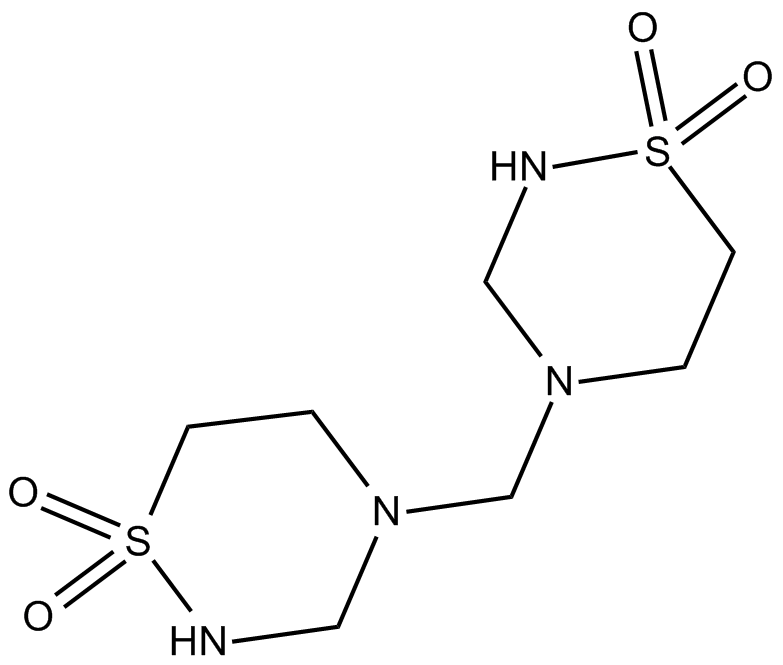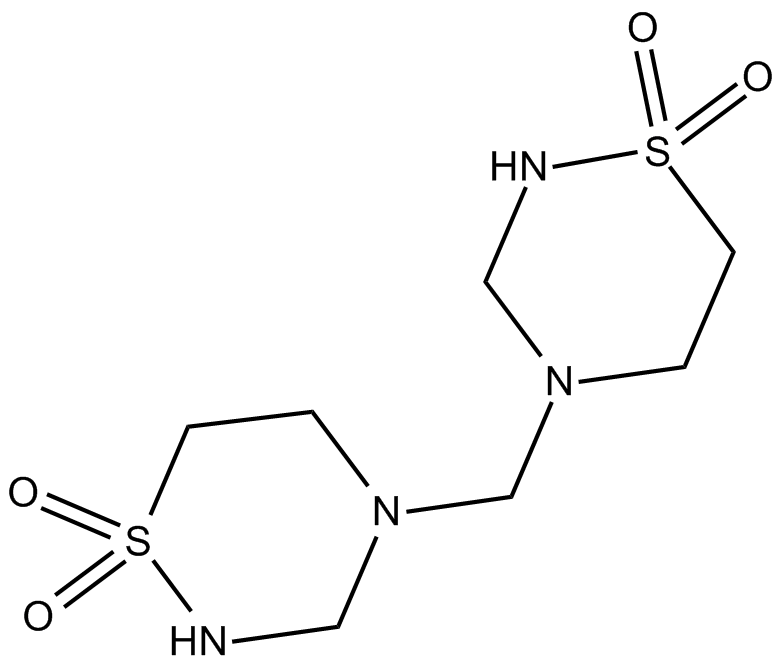Taurolidine
IC50: 9.6-34.2 microM for several cancer cell lines
Taurolidine is a synthetic taurine analog with antimicrobial and anti-neoplastic actions.
Taurine, a conditionally-essential amino acid, is not utilized in protein synthesis, but is found free or in simple peptides. Taurine has been shown to be essential in mammalian development. In vitro studies have demonstrated that low levels of taurine are associated with various pathological lesions.
In vitro: Previous study found that in selected human and murine tumor cell lines, a 3-day exposure to taurolidine could inhibit the growth of all of the cell lines. Further mechanistic study showed that in NIH-3T3 murine fibroblasts and the PA-1 and SKOV-3 human ovarian tumor cells, a 48-h exposure to taurolidine had little effect on cell cycle distribution in PA-1 and SKOV-3 cells but greatly increased the appearance of DNA debris, an effect consistent with an induction of apoptosis. In contrast, in NIH-3T3 cells, taurolidine exposure did not increase DNA debris in the sub-G(0)/G(1) region [1].
In vivo: Animal study found that the i.v. administration of 2% taurolidine and 3% taurolidine as well the i.p. application of 2% taurolidine could decrease the development of advanced i.p. tumor lesions. No changes of differential blood count nor relevant animal weight changes resulted. Moreover, taurolidine did not impair the liver tissue, kidneys, SVC, and leucopoiesis. The intravenous therapy of 2% taurolidine was found to be safe and anti-tumorigenic in advanced local tumor growth in rats [2].
Clinical trial: So far, no clinical study has been conducted.
References:
[1] Calabresi, P. ,Goulette, F.A. and Darnowski, J.W. Taurolidine: Cytotoxic and mechanistic evaluation of a novel antineoplastic agent. Cancer Research 61(18), 6816-6821 (2001).
[2] Braumann C, Stuhldreier B, Bobrich E, Menenakos C, Rogalla S, Jacobi CA. High doses of taurolidine inhibit advanced intraperitoneal tumor growth in rats. J Surg Res. 2005 Nov;129(1):129-35.
| Physical Appearance | A crystalline solid |
| Storage | Store at -20°C |
| M.Wt | 284.4 |
| Cas No. | 19388-87-5 |
| Formula | C7H16N4O4S2 |
| Solubility | insoluble in EtOH; ≥2.64 mg/mL in H2O with gentle warming and ultrasonic; ≥52.8 mg/mL in DMSO |
| Chemical Name | 4,4'-methylenebis(tetrahydro-1,2H,4-thiadiazine) 1,1,1',1'-tetraoxide |
| SDF | Download SDF |
| Canonical SMILES | O=S1(NCN(CN(CC2)CNS2(=O)=O)CC1)=O |
| Shipping Condition | Small Molecules with Blue Ice, Modified Nucleotides with Dry Ice. |
| General tips | We do not recommend long-term storage for the solution, please use it up soon. |
| Cell experiment [1]: | |
|
Cell lines |
PA-1 and SKOV-3 tumor cell lines |
|
Preparation method |
The solubility of this compound in DMSO is ≤ 10mg/ml. General tips for obtaining a higher concentration: Please warm the tube at 37 ℃ for 10 minutes and/or shake it in the ultrasonic bath for a while. Stock solution can be stored below -20℃ for several months. |
|
Reacting condition |
25 μM, 50 μM, 100 μM |
|
Applications |
The results showed that in PA-1 and SKOV-3 tumor cell lines, 24-hour exposure to taurolidine caused a significant concentration-dependent increase in Annexin-V binding. In contrast, in NIH-3T3 cells, taurolidine exposure resulted in no significant increase in antibody binding rate (~ 5%). |
| Animal experiment [1]: | |
|
Animal models |
Nude mice bearing human ovarian tumor xenografts |
|
Dosage form |
5 to 30 mg/mouse, a 3-day i.p. |
|
Application |
The results of the study indicate that doses below 15 mg / mouse / day (~ 650 mg / kg / day) are well tolerated. These dosage regimens resulted in a weight loss of 7% or less and returned to pre-injection levels within 7 days after the injection regimen. With a dose of 20 mg / mouse / day or greater, more pronounced toxicity was observed. The minimum weight loss for the regimens using 20, 25, or 30 mg / mouse was -12%, -16%, and -25%, respectively. In addition, the above taurolidine dosage regimens resulted in mortality rates of 13%, 43%, and 100%, respectively. |
|
Other notes |
Please test the solubility of all compounds indoor, and the actual solubility may slightly differ with the theoretical value. This is caused by an experimental system error and it is normal. |
|
References: [1]. Calabresi P, Goulette FA, Darnowski JW. Taurolidine: cytotoxic and mechanistic evaluation of a novel antineoplastic agent. Cancer Res. 2001 Sep15;61(18):6816-21. PubMed PMID: 11559556. |
|
Quality Control & MSDS
- View current batch:
Chemical structure









